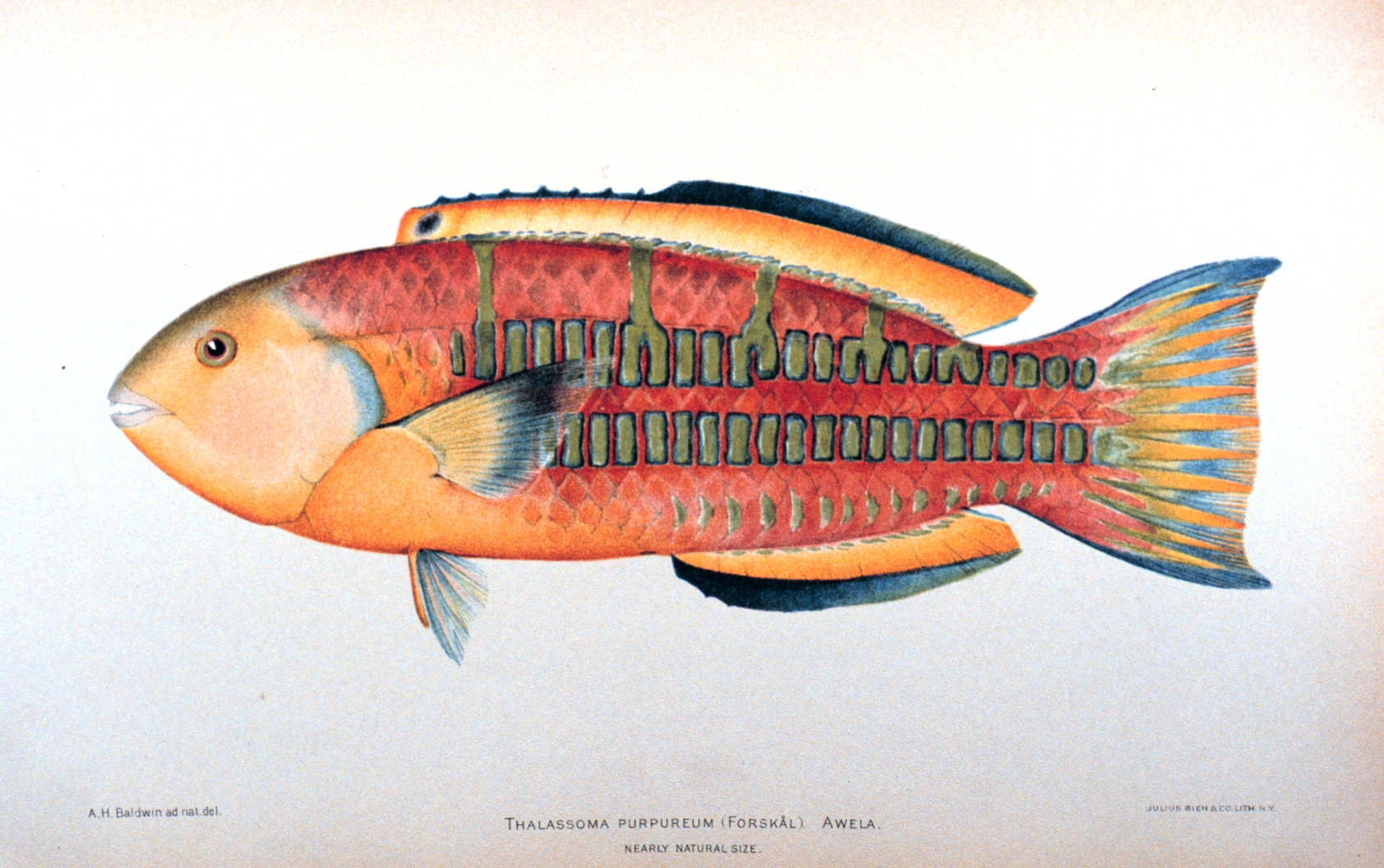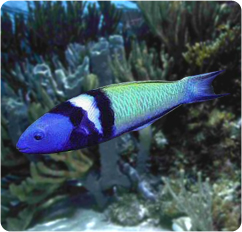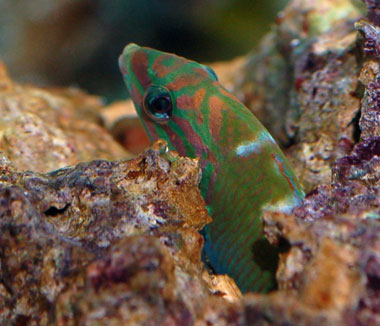|
Genus Thalassoma - Banana Wrasses
Fairly Hardy, Beautifully Colored Wrasses
 |
| An illustration of the surge wrasse (Thalassoma purpureum) as it appeared in The Shore Fishes of the Hawaiian Islands, with a General Account of the Fish Fauna by David Starr Jordan and Barton Warren Evermann (1903) |
Wrasses from the genus Thalassoma are identifiable by way of their banana or cigar-like shape, their unique way of swimming and their generally striking coloration. Like most wrasses (Family Labridae), they possess a protrusable jaw, which aids in foraging in nooks and crannies on the reef. Originating from the Greek and translating roughly as “the color of the sea,” the name Thalassoma came into common scientific usage in 1839 when William John Swainson renamed Scarus purpureus as Thalassoma purpureus. There are roughly 30 species in the genus that inhabit tropical and subtropical reefs in every major ocean.
A Popular and Prized Aquarium Fish
As early as the second decade of the twentieth century, wrasses from this genus were prized aquarium fishes, as the 1919 Guide to the New York Aquarium by Charles Townsend attests:
The most striking in coloration of all the wrasses is the bluehead (Thalassoma bifasciatus). The head is deep blue, the posterior half of the body green, sometimes taking on a yellow tinge. A slim but active little fish, it paddles its way about the tank with the pectoral fins only. It inhabits the reefs of Florida, Bermuda, Bahamas and West Indies.
 |
| "The most striking in coloration of all the wrasses is the bluehead (Thalassoma bifasciatus)" - The New York Aquarium (1919) |
As of 1922, the Aquarium also had a so-called “Reef Fish (Thalassoma nitidum)” on display. Today, many individual species from the genus make fine aquarium specimens that, although semi-aggressive to aggressive (and generally not considered reef-compatible), grow to about six to nine inches (some get much larger) in the aquarium. The smallest is the under-four-inch greenfish (T. ascensionis), while the largest is the surge wrasse (T. purpureum), which can reach 18 inches in length. In addition to being beautiful, active fishes, these wrasses are quite useful as natural predators of parasitic nudibranchs.
Introducing a Thalassoma Species
It is wise to add any Thalassoma species close to the end of your planned stocking, as these fishes can become quite territorial and display aggressive behavior toward any similar or smaller sized fish which you add later. While fairly hardy, these fishes—especially larger specimens—are notoriously poor shippers. As juveniles, some Thalassoma wrasses (e.g., paddlefin wrasse, T. lucasanum) will clean parasites off of other fish. A few of the species will host in anemones as juveniles.
Triggerfishes, tangs and angelfishes make great tankmates for most Thalassoma wrasses. Thalassoma wrasses can only be considered reef safe “with caution,” as they are known to eat both nuisance and ornamental invertebrates. They should leave coral alone, but your small fishes may not be so lucky. While Thalassoma wrasses do not absolutely need a sandbed (like some other wrasses), they prefer a tank that has one, as they will burrow when frightened. At night they will sleep on the sandbed or amongst rockwork and coral branches.
 |
| The head of a lunare wrasse (Thalassoma lunare) |
Plan on keeping only one male per aquarium unless the aquarium is very large. While these fishes live in harems in the wild, a male female pair should only be attempted in an aquarium that is 135 gallons or larger. They are protogynous hermaphrodites--females can become males if the dominant male dies. There is often significant color and size difference between the sexes, but, unlike some other protogynous hermaphrodites, Thalassoma wrasses require another Thalassoma wrasse to be present in order to change sexes.
Finally, these fishes are neither picky about their diet nor are they especially susceptible to disease and parasitic infestation. Thalassoma wrasses are carnivores and will appreciate marine flesh, especially shrimp, mussels, clams, and oysters. They will also happily accept frozen carnivorous foods, pellets and flakes.
A Sampling of Species
Blue head wrasses (Thalassoma bifasciatum) come from the western Atlantic and grow to nearly ten inches (females only to about five inches).
Gold bar wrasses (Thalassoma hebraicum) come from the Indian Ocean and may reach nine inches in length in the aquarium. Of the many species in this genus, this is one of the best suited for aquarium life.
 |
| Hardwick’s Wrasse |
Hardwick’s wrasses (Thalassoma Hardwicke), also called six-bar wrasses, come from the Indo-Pacific and Red Sea and usually reach eight inches in length in the aquarium.
Jansen’s wrasses (Thalassoma jansenii) come from the Indo-West Pacific and grow to about seven or eight inches in the aquarium. This is a particularly hardy member of the genus.
Klunzinger’s wrasses (Thalassoma rueppellii) come from the Red Sea and grow to about eight inches in the aquarium.
 |
| Lime Green Wrasse |
Lime green wrasses (Thalassoma lutescens), sometimes called the yellow moon wrasse, come from the Indo-Pacific and will grow to close to ten inches.
Lunare wrasses (Thalassoma lunare), also called moon wrasses, come from the Red Sea and the Indian Ocean and grow to about ten inches in length.
Paddlefin wrasses (Thalassoma lucasanum), also known as Cortez rainbow wrasses or lollipop wrasses, come from the eastern Pacific and grow to about half a foot in length. Very hardy.
 |
| Adult Rainbow Wrasse |
Rainbow wrasses (Thalassoma quinquevittatum) come from the Indo-Pacific and may grow to about six inches. Not as hardy as other members of the genus.
Surge wrasses (Thalassoma purpureum) come from the Indo-Pacific and the Red Sea and can reach eighteen inches in length.
Blacktail wrasses (Thalassoma ballieui) come from the eastern Pacific (especially Hawaii) and, while they get quite large (more than a foot), are very hardy members of the genus.
 |
| Paddlefin Wrasse |
Saddle wrasses (Thalassoma duppery) come from the Hawaiian Islands and reach ten inches in length.
Sunset wrasses (Thalassoma grammaticum) come from the eastern Pacific and grow to a foot in length.
Published 25 August 2008. © Blue Zoo Aquatics
|